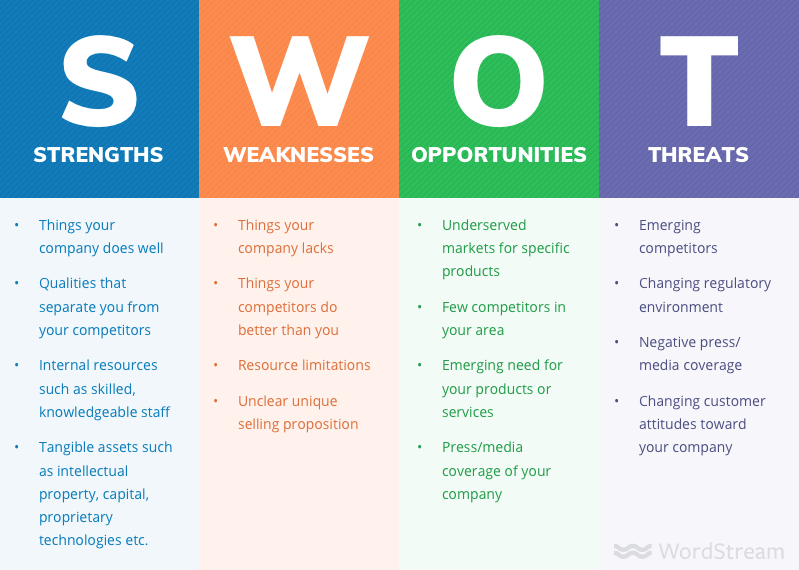Table of Contents
What is a SWOT Analysis?
How to Prepare for a SWOT Analysis
Identifying Strengths and Weaknesses
Identifying Opportunities and Threats
Analysing the Results of a SWOT Analysis
Developing Strategies Based on a SWOT Analysis
Implementing the Strategies
Monitoring and Evaluating the Strategies
What is a SWOT Analysis?
A SWOT analysis is a technique for analysing the strengths, weaknesses, opportunities and threats that affect a business. It’s used to identify the internal and external factors that can help or hinder the achievement of goals.
The acronym “SWOT” stands for:
Strengths & Weaknesses: Identify Internal Factors.
- Strengths (S) – The positive aspects of your business. These are internal factors within your control that give you an advantage over competitors in some way. They may include such things as experience in the field or having a great team on board; they could also be things like having a patent on an innovative product idea or being located near customers’ offices so they can easily visit you if needed.
- Weaknesses (W) – The negative aspects of your business which are internal factors within your control but need improvement before they become strengths again–or even just neutralized enough so they don’t cause problems anymore! For example, maybe there’s some kind of technology glitch affecting how well salespeople can access customer data on their computers? Or perhaps there isn’t enough storage space available at headquarters? Whatever it might be…this would be considered one type of weakness here because it affects how well employees perform their jobs.”
Opportunities & Threats: Evaluate External Factors.
Now that you have a good understanding of the internal factors, it’s time to focus on external opportunities and threats.
- Opportunities are conditions that could benefit the business if certain actions were taken. This could include changes in market trends or improved technology.
- Meanwhile, threats are potential risks to the business that should be monitored and addressed if they occur. Potential threats could include competition, changing customer preferences, or new regulations and laws.
Evaluating opportunities and threats is key when it comes to developing a successful SWOT analysis. Gaining insights into external factors beyond your business’s control will give you a better understanding of potential risks and rewards for different courses of action.
Take the time to seek out sources such as news articles, customer polls, or industry reports that provide valuable information about the external environment of the market or segment in which you operate.
Note any specific changes—both positive and negative—and determine how they may affect your business. Doing this step in-depth will provide you with an invaluable outlook on potential future strategies.

Image source: WordStream
How to Prepare for a SWOT Analysis
- Identify the goals of your SWOT analysis.
- Gather information about your company and its competitors, including:
- Historical data (e.g., revenue, profits)
- Current market conditions (e.g., industry trends)
- Company resources (e.g., employees)
- Competitor information (e.g., strengths/weaknesses).
Identifying Strengths and Weaknesses
When conducting a SWOT analysis, you should start looking at the internal factors that could be affecting your business. Strengths are the qualities of a product or service that makes it better than its competitors. You should list any advantages or capabilities that make your company stand out from its competitors. Weaknesses are any areas where your current setup is not performing well and needs improvement. Look for areas where processes need to be improved and costs can be reduced in order to give the business an edge.
Strengths
- You have a loyal customer base.
- Your brand is well-known in the industry.
- Your company has been in business for a long time and has an established reputation among customers, employees and vendors alike.
Weaknesses
- The competition is fierce and you are not able to keep up with them on price or quality of service/product offerings.
Identifying Opportunities and Threats
External Opportunities:
- The new law on solar energy is expected to boost demand for solar panels.
- The recent increase in the number of electric vehicles has increased demand for solar panels.
- The government has recently announced its plan to make all new houses have solar panels by 2023. This will increase demand for solar panels as more people will need them to power their homes.
Internal Opportunities:
- There are many research laboratories that are working on developing new types of solar panels, which could help us improve our product and increase sales if we can get our hands on their technology before our competitors do.
- -We have a lot of experience in manufacturing products similar to ours, so we know how to make them better than our competitors do, which means we could use this knowledge to create a product that stands out from the rest and makes us more competitive than them when it comes time for customers to decide who they should buy from instead!
External Threats:
- Retailers may not be able to sell our product because they don’t believe it will be profitable enough.
Analysing the Results of a SWOT Analysis
- Opportunities:
- Potential Problems:
- Strategies:
Tips to Get the Most out of Your SWOT Analysis.
Once you have a complete list of your strengths, weaknesses, opportunities and threats, the next step is to prioritise them. Before making decisions, consider the impact of each item on your business goals and objectives.
For example, if one of the threats identified is increased competition in a certain market segment, figure out how that would affect sales and possibly necessitate changes in pricing or marketing strategies. Then prioritise that threat as either critical or minor and act accordingly.
A SWOT analysis is most effective when it’s done in a workshop or even a team setting so everyone has an opportunity to express their thoughts.
During the process, open communication is encouraged and individuals can bounce ideas off each other regarding any potential outcomes.
In addition to brainstorming and soliciting opinions, having multiple people involved can help bring clarity and nuance to the conversation as different viewpoints can lead to more comprehensive results.
Additionally, consider the timeframe for each task: for example, if you have identified a weakness that needs immediate attention, you might plan out actionable steps that must occur within one year or less.
Through these collaborative meetings, then, your team will be able to identify which goals are attainable and plan accordingly.
Developing Strategies Based on a SWOT Analysis
Once the SWOT analysis is complete, the results should be used to inform strategic planning and developing growth strategies. The strengths of your business can be used as opportunities for further development and success, while weaknesses should be addressed to improve performance. Threats should also be responded to both defensively — by reducing their impact — or offensively, depending on the context. Finally, any external opportunities should be utilised for their most optimal potential.
- Create a strategy to take advantage of your strengths and opportunities: If you have identified any strengths or opportunities in your SWOT analysis, this is where you’ll want to focus your efforts in order to capitalise on them. For example: “Our company has strong relationships with customers because we have been providing them with excellent service for years.” This could translate into something like “We should continue providing excellent customer service because it helps us retain existing customers while also attracting new ones.”
- Create another strategy for overcoming weaknesses or threats: When developing this type of strategy–which may also involve taking action against an opponent–it’s important not only that you recognise what needs improvement but also understand why those things need improving before taking any action towards addressing them (e.g., if there are too many competitors offering similar products/services).
Implementing the Strategies
To implement your strategies, you need to assign tasks and resources. You also need to set a timeline for each one. The first step is determining who will do what and when they’ll do it by. That way, you can make sure everything gets done in time for the next phase of your project or campaign.
Monitoring and Evaluating the Strategies
Once you have identified your strengths, weaknesses, opportunities and threats, it’s time to monitor progress. Are you making progress towards your goals? If not, why not?
If so, what strategies are working well and which ones need adjusting? It’s important that you don’t stop here though–you should always be looking at ways of improving your business operations and identifying new opportunities.
Conclusion
A SWOT analysis is a great way to determine the strengths, weaknesses and opportunities of your business.
It’s also an effective tool for identifying threats that could impact your company’s growth.
If you’re looking to improve your business strategy or make changes in the way things are done at work, then doing a SWOT analysis can help you identify areas where improvements need to be made and what those improvements should look like.
Ready to put it all into practice for your own business? Here’s our free, editable, SWOT analysis template.
It’s a Google Sheet so you can add and remove rows, edit and answer the questions, paste into a slide deck, and more.
FAQs
Q: What is a SWOT analysis?
A: A SWOT analysis is a method for evaluating the strengths, weaknesses, opportunities and threats that affect an organisation or project. SWOT stands for Strengths, Weaknesses, Opportunities and Threats.
The purpose of a SWOT analysis is to help you identify what’s working well in your business or project and where there are potential areas for improvement. It can also help you plan how to take advantage of opportunities while minimising any potential threats that may arise from outside sources such as competitors or economic conditions.
Q: How do I do a SWOT analysis?
A: There are many ways to conduct this type of assessment but one common approach involves creating four columns on paper or in an electronic document like Microsoft Word: Strengths : What are the key strengths of your organisation? For example, maybe it’s got great customer service or has won awards for its products or services. Weaknesses : What are some of your organisation’s weaknesses? For example, maybe it doesn’t have enough money to buy new equipment or expand into new markets. Opportunities : What opportunities exist right now within your industry? For example, maybe there’s an opportunity to expand into new markets with less competition..
Need Help? Reach out and we’ll get you up and running..
Dedicated To Your Business Success
John









